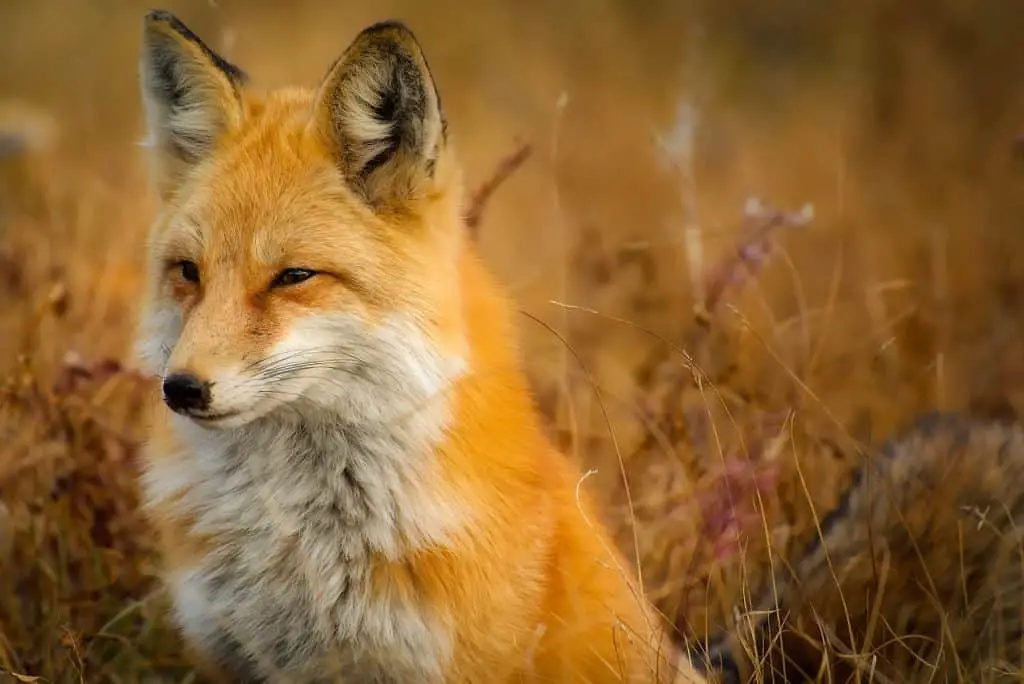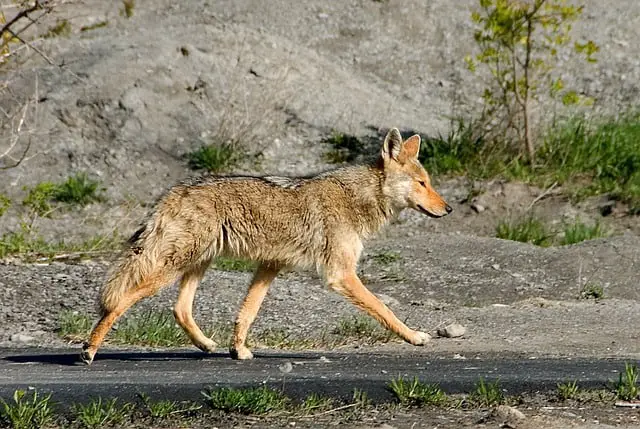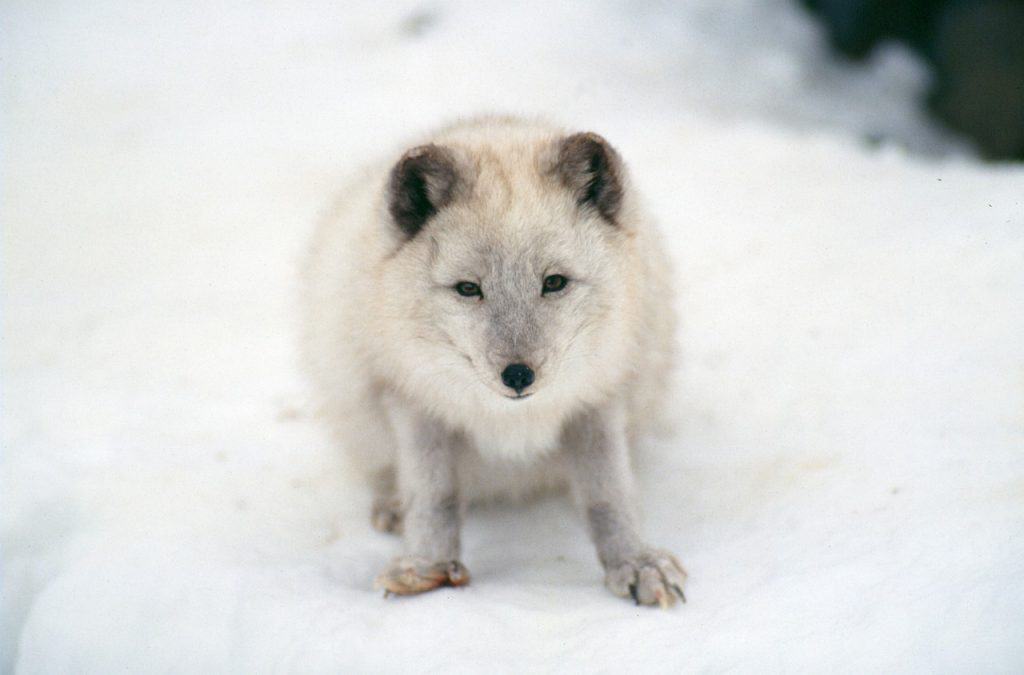When you spot a canine in the distance, your first thought might be it’s a coyote or a fox. Although these animals might seem very similar, there are some key differences between foxes vs coyotes that set these species apart. In this article, I will walk you through the big differences between these two beautiful species.
Key highlights:
- Foxes are smaller than coyotes.
- While coyotes live within a social pack, foxes tend to live a solitary existence.
Foxes vs Coyotes: Scientific Classification
The first difference between foxes and coyotes is their scientific classification. While closely related, these animals are two distinct species.
Here’s the scientific classification of coyotes:
- Kingdom: Animalia
- Phylum: Chordata
- Class: Mammalia
- Order: Carnivora
- Family: Canidae
- Genus: Canis
- Species: Canis latrans

Note: The picture above is of a coyote.
Importantly, the U.S. Department of Fish and Wildlife recognizes 19 subspecies of coyotes.
Here’s the scientific classification of foxes:
- Kingdom: Animalia
- Phylum: Chordata
- Class: Mammalia
- Order: Carnivora
- Family: Canidae

Note: The picture above is of a red fox.
As of writing, there are over 20 recognized species of foxes in the world. One of the most easily recognizable types of foxes is the red fox (Vulpes vulpes.) But even the red fox has several recognized subspecies to keep track of. With that, foxes are more genetically diverse than coyotes.
Physical Differences
Foxes and coyotes are two distinct members of the Canidae family, each showcasing unique physical attributes. Foxes, known for their sleek appearance, have a slender body frame, characterized by a bushy tail and a pointed muzzle. They typically exhibit a range of colors, from red and gray to white and silver, depending on the species. Their delicate and agile build allows them to swiftly navigate through diverse habitats, such as forests, grasslands, and even urban environments.
On the other hand, coyotes possess a sturdier build with a slightly larger frame. They have a thick, bushy tail and a more elongated snout, giving them a somewhat dog-like appearance. Coyotes are predominantly grayish-brown in color, with patches of tan and black. Their robust physique enables them to adapt to various terrains, including deserts, mountains, and prairies.
In terms of size, foxes tend to be smaller compared to coyotes. The average fox measures around 15 to 20 inches in height and weighs between 6 to 15 pounds, depending on the species. In contrast, coyotes stand at an average height of 21 to 24 inches and weigh anywhere between 20 to 50 pounds. These differences in size contribute to variations in their hunting strategies and prey preferences.
Behavioral Differences

Note: The image above is of a coyote.
Foxes and coyotes, though belonging to the same family, exhibit distinct behavioral patterns. Foxes are known for their cunning and adaptable nature. They are skilled hunters, often employing stealth and agility to catch their prey. Foxes are primarily solitary animals, although they may form small family groups during breeding seasons. They are territorial and mark their territories with urine and scent glands to communicate their presence.
In contrast, coyotes are highly social creatures, often living in family units called packs. These packs consist of an alpha pair and their offspring. Coyotes are known for their remarkable communication skills, utilizing a range of vocalizations such as howls, yips, and barks to convey messages within their pack or to other coyotes in the vicinity. Their social structure facilitates cooperative hunting, as they work together to pursue and capture prey.
Both foxes and coyotes are opportunistic omnivores, meaning they have a flexible diet that includes small mammals, birds, reptiles, insects, fruits, and vegetation. However, foxes are more inclined towards consuming small mammals and birds, while coyotes have a broader diet and can even scavenge for carrion when necessary.
Foxes vs Coyotes: Habitat

Note: The image above is of a Fennex fox.
These species have distinct preferences when it comes to their living environments. Foxes are highly adaptable creatures that can thrive in a wide range of habitats, including forests, grasslands, mountains, and even urban areas. They possess the ability to adjust their behavior and diet according to the resources available in their surroundings.
Coyotes also display a remarkable ability to inhabit diverse landscapes. They are known to occupy a variety of habitats, including deserts, forests, plains, and even urban areas. Coyotes have successfully adapted to human-altered environments, demonstrating their versatility in coexisting with human populations.
Although there may be overlap in certain habitats, foxes tend to prefer denser vegetation and forested areas, providing cover and suitable hunting grounds. They are adept at utilizing the natural features of these habitats for shelter and protection. In contrast, coyotes exhibit a broader tolerance for open spaces, such as prairies and grasslands, where they can spot potential prey from a distance and take advantage of their speed and agility during pursuits.
Foxes vs Coyotes: Distribution
Foxes can be found in diverse habitats worldwide, including North America, Europe, Asia, Africa, and Australia. Specific species of foxes, such as the red fox, Arctic fox, and gray fox, occupy specific regions within these continents, adapting to a wide range of climates and environments.
Coyotes, on the other hand, are primarily distributed throughout North and Central America. They have a vast geographic range, spanning from Canada to Mexico. Coyotes have demonstrated remarkable adaptability to different landscapes, from deserts and grasslands to forests and urban areas. They have even expanded their range into cities and suburban regions, showcasing their ability to coexist with human populations.
Foxes vs Coyotes: Vocalizations
Both foxes and coyotes communicate through a variety of vocalizations, each with its own distinct purpose. Foxes are known for their piercing and high-pitched calls, which include barks, screams, and howls. These vocalizations serve as territorial displays, mating signals, or as a means to communicate with other members of their family group.
Coyotes, on the other hand, have a vast repertoire of vocalizations that range from howls, yips, barks, growls, and even huffs. Their howls are particularly iconic and are often used as a form of long-distance communication. Howls help to establish their presence, maintain social bonds within their pack, and serve as a vocal declaration of territory.
Comparison: Foxes vs Coyotes
Below is a handy breakdown of some of the key differences between coyotes and foxes.
Body Size

Foxes and coyotes exhibit notable differences in their body sizes. Foxes are generally smaller in size compared to coyotes. Depending on the species, foxes can measure anywhere from 14 to 24 inches in height at the shoulder and weigh between 6 to 30 pounds. Their compact build allows them to navigate through various terrains with agility and speed.
In contrast, coyotes are larger and more robust in stature. They typically stand around 21 to 26 inches in height at the shoulder and can weigh between 20 to 50 pounds. With their longer legs and muscular bodies, coyotes possess the physical strength and endurance to cover extensive distances in pursuit of prey.
The disparity in body size between foxes and coyotes plays a crucial role in their hunting strategies and dietary preferences. Foxes, being smaller, are adept at capturing smaller prey such as rodents, rabbits, and birds. Coyotes, with their larger size and hunting capabilities, are capable of taking down larger prey like deer or hunting in packs to tackle more substantial game.
Coat Color

Note: The image above is of an Arctic fox.
Foxes exhibit a wide range of coat colors, including red, gray, silver, brown, and even white. The specific coloration depends on the species and their geographical location. Red foxes, for instance, are known for their vibrant reddish-orange coats, while Arctic foxes have thick white fur that helps them blend into snowy environments.
In contrast, coyotes primarily exhibit shades of gray, tan, and brown in their coats. The coloration of coyotes often serves as effective camouflage in their natural habitats, such as deserts, grasslands, and forests. The variation in coat colors can also be influenced by factors such as climate and seasonality, with coyotes having a tendency to develop thicker and darker coats during colder months.
Tail

Note: The image above is of a coyote.
Foxes are known for their bushy tails, which are long, fluffy, and often held upright. The bushy tail serves multiple purposes, including balance during agile movements, insulation against cold weather, and visual signaling during social interactions and territorial displays.
In contrast, coyotes have less bushy tails that are typically held horizontally or lowered. The coyote’s tail helps them with balance, especially when running at high speeds or making sharp turns during pursuits. Coyotes also use their tails as communication tools, with various positions and movements conveying different messages to other coyotes in their pack.
| Fox | Coyote | |
| Weight | 5 to 30 pounds (1 to 14 kg) | 20 to 50 pounds (7 to 23 kg) |
| Color | Varies including red, brown, black, white, silver, gray | Gray or reddish-brown |
| Distribution | Many species around the world | A single species in North America |
| Height (at the shoulder) | 14 to 24 inches | 21 to 26 inches |
Frequently Asked Questions: Foxes vs Coyotes
You have questions about foxes and coyotes. I have answers.
Are foxes aggressive?
In general, foxes aren’t considered aggressive. While these predators track down prey, it’s highly unusual for a fox to have a negative interaction with a human. Instead, foxes tend to avoid any level of human contact.
Are coyotes a threat to foxes?
Coyotes can pose a threat to foxes as they are known to be opportunistic predators. In areas where their ranges overlap, coyotes may compete with foxes for resources such as food and territory. Additionally, coyotes have been observed preying on foxes, especially if they perceive them as competition or as a potential food source. However, the level of threat can vary depending on factors such as habitat, population densities, and availability of prey.
Which is bigger a coyote or a fox?
A coyote is generally bigger than a fox. On average, coyotes are taller and heavier than foxes. Coyotes typically stand around 21 to 26 inches in height at the shoulder and can weigh between 20 to 50 pounds, whereas foxes are smaller, measuring about 14 to 24 inches in height and weighing between 6 to 30 pounds, depending on the species.
Can a fox and coyote mate?
No. Foxes and coyotes don’t mate. However, coyotes can choose to mate with dogs and wolves.
Final Take
Foxes and coyotes are both impressive species that thrive in a range of habitats. If you spot a creature and aren’t sure it’s a fox or coyote, the size and location can be a dead giveaway. While foxes tend to be smaller, there are more species of foxes distributed across the world. So, if you spot a larger animal in North America, you are likely looking at a coyote.